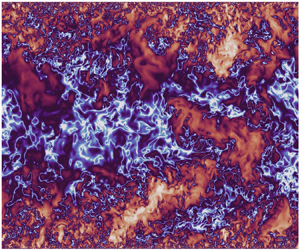Article contents
The mean logarithm emerges with self-similar energy balance
Published online by Cambridge University Press: 01 October 2020
Abstract

The attached eddy hypothesis of Townsend (The Structure of Turbulent Shear Flow, 1956, Cambridge University Press) states that the logarithmic mean velocity admits self-similar energy-containing eddies which scale with the distance from the wall. Over the past decade, there has been a significant amount of evidence supporting the hypothesis, placing it to be the central platform for the statistical description of the general organisation of coherent structures in wall-bounded turbulent shear flows. Nevertheless, the most fundamental question, namely why the hypothesis has to be true, has remained unanswered over many decades. Under the assumption that the integral length scale is proportional to the distance from the wall  $y$, in the present study we analytically demonstrate that the mean velocity is a logarithmic function of
$y$, in the present study we analytically demonstrate that the mean velocity is a logarithmic function of  $y$ if and only if the energy balance at the integral length scale is self-similar with respect to
$y$ if and only if the energy balance at the integral length scale is self-similar with respect to  $y$, providing a theoretical basis for the attached eddy hypothesis. The analysis is subsequently verified with the data from a direct numerical simulation of incompressible channel flow at the friction Reynolds number
$y$, providing a theoretical basis for the attached eddy hypothesis. The analysis is subsequently verified with the data from a direct numerical simulation of incompressible channel flow at the friction Reynolds number  $Re_\tau \simeq 5200$ (Lee & Moser, J. Fluid Mech., vol. 774, 2015, pp. 395–415).
$Re_\tau \simeq 5200$ (Lee & Moser, J. Fluid Mech., vol. 774, 2015, pp. 395–415).
JFM classification
- Type
- JFM Rapids
- Information
- Copyright
- © The Author(s), 2020. Published by Cambridge University Press
References
REFERENCES
- 11
- Cited by





